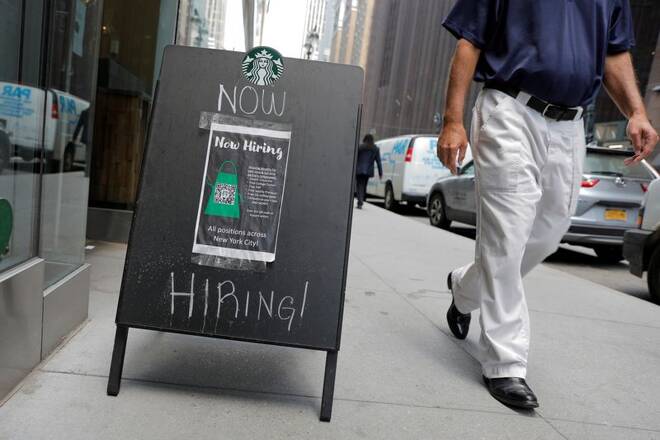Advertisement
Advertisement
US labor market stays resilient; Q4 labor costs revised higher
By:
WASHINGTON (Reuters) - The number of Americans filing new claims for unemployment fell again last week, pointing to sustained labor market strength that could keep the Federal Reserve raising interest rates.
By Lucia Mutikani
WASHINGTON (Reuters) – The number of Americans filing new claims for unemployment benefits fell again last week, pointing to sustained labor market strength and adding to financial market fears that the Federal Reserve could keep hiking interest rates for longer.
Those worries were further heightened by another report from the Labor Department on Thursday showing labor costs grew much faster than previously estimated in the fourth quarter. The labor market remains tight despite rising risks of a recession, contributing to keeping inflation elevated via solid wage gains.
“The labor market shows no fresh signs of deterioration with minimal job layoffs despite the news of big tech firings the last several months, and this will harden the resolve of Fed officials to slow economic demand down with higher interest rates,” said Christopher Rupkey, chief economist at FWDBONDS in New York.
Initial claims for state unemployment benefits dropped 2,000 to a seasonally adjusted 190,000 for the week ended Feb. 25, the Labor Department said. It was the seventh straight week that claims remained below 200,000. Economists polled by Reuters had forecast 195,000 claims for the latest week.
Unadjusted claims dropped 9,297 to 201,710 last week. The decline was led by California and Kentucky. There were notable decreases in claims in Michigan, Ohio and Texas. Big increases in claims were reported in Massachusetts and Rhode Island.
There is still no sign that high-profile layoffs, mostly in the technology sector, have had a material impact on the labor market, with economists and policymakers saying these companies hired too many workers during the COVID-19 pandemic and were not representative of the overall economy.
Economists also speculated that severance packages were keeping some laid-off workers, most of them highly paid, from filing claims. With 1.9 job openings for every unemployed person in December, people who have lost their jobs may be finding works easily.
Seasonal adjustment factors, the model the government uses to strip out seasonal fluctuations from the data, also may be keeping claims lower, according to economists. The seasonal adjustment factors for 2023 will be updated at the end of March.
But even using alternative seasonal adjustments, economists say the labor market still is exhibiting tightness. Employers generally appear reluctant to let go of workers following difficulties finding labor during the pandemic.
An Institute for Supply Management survey on Wednesday found that sentiment among respondents’ companies “still favors attempting to hire rather than reducing employment levels.”
Stocks on Wall Street were trading mostly lower. The dollar rose against a basket of currencies. U.S. Treasury prices fell.
Graphic-Jobless claims and planned layoffs https://www.reuters.com/graphics/USA-STOCKS/mypmoaxoepr/joblessclaims.png
High inflation
Labor market resilience and stubbornly high inflation have increased the odds the Fed will raise interest rates at least three more times this year instead of twice. The U.S. central bank has hiked its policy rate by 450 basis points since last March from the near-zero level to the current 4.50%-4.75% range, with the bulk of the increases coming between May and December.
Inflation could remain high. A second report from the Labor Department showed unit labor costs – the price of labor per single unit of output – grew at a 3.2% annualized rate last quarter. That was revised up from the 1.1% pace reported last month. Labor costs accelerated at a 6.9% rate in the third quarter, and notched hefty gains in the prior two quarters.
They surged 6.5% in 2022, instead of 5.7% as reported last month. Economists estimated that labor costs were running at a pace consistent with underlying inflation slowing to 4% by the end of the year, double the Fed’s 2% inflation target.
The core personal consumption expenditures price index, one of the measures tracked by the Fed for monetary policy, increased 4.7% in January.
Hourly compensation grew 4.7% in 2022. It averaged 5.0% in the past five years, well above the 3% that is viewed by some policymakers as compatible with the inflation target.
Higher labor costs meant nonfarm productivity, which measures hourly output per worker, grew at only a 1.7% rate last quarter, downgraded from the previously reported 3.0% pace.
“The revised data suggest that the underlying inflation problem in the U.S. is worse than previously thought,” said Michael Pearce, lead U.S. economist at Oxford Economics in New York. “That helps to explain the persistence of sticky services price inflation, which is mostly a reflection of domestically-driven wage costs.”
Graphic-U.S. productivity and labor costs https://www.reuters.com/graphics/USA-STOCKS/jnvwyabywvw/laborcostsprod.png
The claims report showed the number of people receiving benefits after an initial week of aid fell 5,000 to 1.655 million during the week ending Feb. 18. The so-called continuing claims, a proxy for hiring, covered the period during which the government surveyed households for February’s unemployment rate.
Continuing claims fell modestly between the January and February survey periods. The unemployment rate in January, at 3.4%, was the lowest in more than 53 years. Economists expect strong employment growth in February, though the pace probably slowed from January’s blockbuster gain of 517,000 jobs.
“There is no question that the job market is very strong,” said Stuart Hoffman, senior economic advisor at PNC Financial in Pittsburgh, Pennsylvania. “We expect February payrolls jobs to rise by close to 215,000.”
(Reporting by Lucia Mutikani; Editing by Chizu Nomiyama and Paul Simao)
About the Author
Reuterscontributor
Reuters, the news and media division of Thomson Reuters, is the world’s largest international multimedia news provider reaching more than one billion people every day. Reuters provides trusted business, financial, national, and international news to professionals via Thomson Reuters desktops, the world's media organizations, and directly to consumers at Reuters.com and via Reuters TV. Learn more about Thomson Reuters products:
Advertisement
